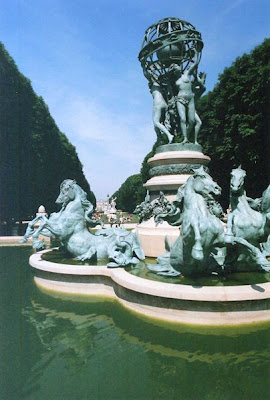 One thing that will never be said about Paris is that it is a green city. Surprisingly small, everything is crammed in, leaving barely any space for an expanse of grass, let alone a sprawling public park.
One thing that will never be said about Paris is that it is a green city. Surprisingly small, everything is crammed in, leaving barely any space for an expanse of grass, let alone a sprawling public park.The Jardin du Luxembourg, a few steps from the Sorbonne, is an exception, an oasis teeming with people seeking respite from the clamor of city life.
The centerpiece is the boating pond, which is approached through terraced formal gardens. That it is called a garden rather than a park is a deliberate statement, the emphasis being on magnificent floral displays rather than vast expanses of lawn. The octagonal pool is surrounded by pots filled with vivid blooms which could pierce through the grayest of days. It's a scene to make you fall in love with the city instantly, particularly when you start looking at the detail.
On the pool’s surface are little wooden boats, colorful and simplistic. They seem to be moving of their own accord, until you see the children with sticks at the water's edge. In an age of Playstations and hundreds of television channels on demand, the joy that comes from simply pushing a toy boat around with a wooden pole is a tribute to the imagination of childhood. From the looks on faces, these kids are fearless navigators, sailing the seven seas to unknown lands.
As you begin to walk round, you realize that this is a paradise for the youthful as well as the nosy people-watchers. As elderly couples remain parked in deck chairs, there is the constant birdsong of juvenile energy twittering through the trees.
Every little stretch is taken up with a different activity. There are tennis courts and areas set aside for boules (lawn bowling). Next door is a small strip devoted to tricycle racing. Girls are mounted on tricycles with wooden horses’ heads slapped onto the front, furiously pedaling around traffic cones – but to all intents and purposes, it's their mini re-enactment of Ben Hur. Most of the noise is coming from opposite the boules arena, though. It's a wonder that the group of middle-aged men (and one “mature” woman) are not being driven to distraction as they solemnly pace, analyze and lob. They are playing out their deadly serious, if somewhat sedate, spectacle to the backdrop of a huge adventure playground.
Just to wander from sector to sector, swigging from a bottle of water, is a delightfully affirmative experience. It's like a scene from 50 years ago, done up with modern costumes, and for the people-watcher, there's just so much to see. So many people, so many activities, so many expressions.
And those expressions extend to the marionnette theatre. This is puppeteering of the strictly old-school variety – an art form, not cheap entertainment – with the carefully carved mannequins treated as characters rather than tools of the trade. Every movement is handled with the love you'd expect from a family business that has been going for 75 years, and the audience laps it up.
There may not be any guns, explosions or cool special effects in Les Adventures De Minouchet, but judging by the reactions, that's the misjudgment of Hollywood rather than puppet-master Francis-Claude Desarthis.
Emerging from the theatre and traveling a few yards, you realize that even sitting outside those famous Parisian cafes, you'd be hard pushed to find a better arena than this. A basketball game getting overly competitive, boys showing off to impress girls, football with chairs for goal posts, a couple throwing a frisbee in lieu of striking up conversation. It's magical in the most simplistic way, and if you can't fall under the charm of Paris here, watching happy children rubbing the manes of their donkeys as they ride around the premises, then heaven help.
David Whitley – The Sun Herald











